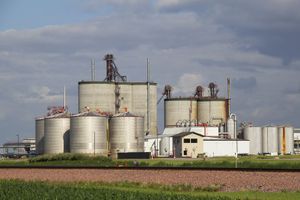Increasing Fuel Demand Helps Ethanol Plants to Improve Profit Margins
 Profit margins for typical dry-mill ethanol plants have improved dramatically since May, as the industry was stuck in the mire of the COVID-19 economic shutdown and virtually no demand for fuels.
Profit margins for typical dry-mill ethanol plants have improved dramatically since May, as the industry was stuck in the mire of the COVID-19 economic shutdown and virtually no demand for fuels.
As an increasing number of people are traveling for the summer months and more states are opening up, improving demand for gasoline has led to rising prices for ethanol.
As a result, profit margins at DTN’s hypothetical 50-million-gallon ethanol plant in South Dakota have improved since our last update on May 22.
Since then, the plant reported a net profit of 4 cents per gallon of ethanol produced, compared to a 16.1-cent loss on May 22. Most ethanol plants are not paying debt. If the hypothetical plant was not paying debt, it would be seeing a 35-cent-per-gallon profit in this latest update. That represents an improvement of 20 cents per gallon.
The improved margins come as a result of a spike in ethanol prices in recent weeks.
For this update, the hypothetical ethanol plant received $1.63 per gallon for its ethanol, based on the rack price — a large jump from $1.27 since May 22.
Early in the COVID-19 shutdown, ethanol prices plummeted to historic lows in the 60- to 70-cent range.
In addition, the plant paid less for corn at $3.40 per bushel for this update, based on the Chicago Board of Trade Futures Price for July. That represents a 40-cent drop from our last update.
The price received for dried distillers grains came in at $113 per ton, down from $135 on May 22.
Mary Kennedy, DTN cash grains analyst, said the ethanol market also received a boost from the Illinois River closing on July 1 for repairs on five lock and dams, stopping barges from moving downriver from the Kinder Morgan Argo, Illinois, terminal.
The closure is expected to last through September 2020, she said, causing buyers to look for other options.
“As for DDG prices helping plant margins out, that hasn’t been much of a factor lately,” Kennedy said.
“DDG demand is still weak as maintenance diets are still being used by feeders and the recent stretch of hot weather brings down caloric intake for livestock. DDG prices have also needed to stay competitive with other corn coproduct and byproduct feed prices, most of which have been weaker as well due to the effects of COVID-19 on slaughterhouses.”
According to a July 2020 CoBank analysis, the industry continues to face headwinds during the next few months.
“However, looking out three months, the industry faces both challenges and opportunities,” CoBank said.
“Coronavirus is resurging in several states, and renewed activity restrictions will arguably reduce driving and fuel demand. As for opportunities, road trips and family vacations during the summer months typically means increased fuel consumption, but resurgence of COVID-19 could dampen travel plans.”
In addition, the report said it expects the industry to continue to recover into 2021.
“We believe that ethanol fuel demand may recover to only 85% to 90% of pre-COVID levels,” CoBank said.
“We conclude that the industry will transform and rationalize excess capacity and continue diversifying into higher-margin co-products.”
DTN established Neeley Biofuels in DTN’s ProphetX Ethanol Edition to track ethanol industry profitability. Using the real-time commodity price data that flows into the “corn crush” in ProphetX, and some industry-average figures for interest costs, labor and overhead, DTN is able to track current profits. It also tracks how much Neeley Biofuels would make or lose under an infinite number of “what-if” scenarios.
DTN uses industry-average figures from Iowa State University. Included in the figures are annual labor and management costs, transportation costs, debt-servicing costs, depreciation and maintenance costs. Although Neeley Biofuels is paying debt-service and depreciation costs on its plant, many real plants are not in debt.
Also, it should be noted the calculations include all other costs, such as chemicals and yeasts, electricity, denaturant and water. While DTN uses natural gas spot prices for these updates, many ethanol plants lock in prices on the futures market, so they are not as vulnerable to natural gas market volatility.
Todd Neeley can be reached at todd.neeley@dtn.com
Follow him on Twitter @toddneeleyDTN
Source: Todd Neeley, DTN
